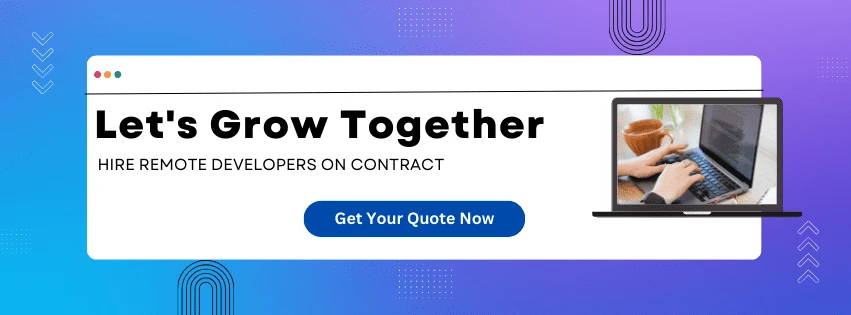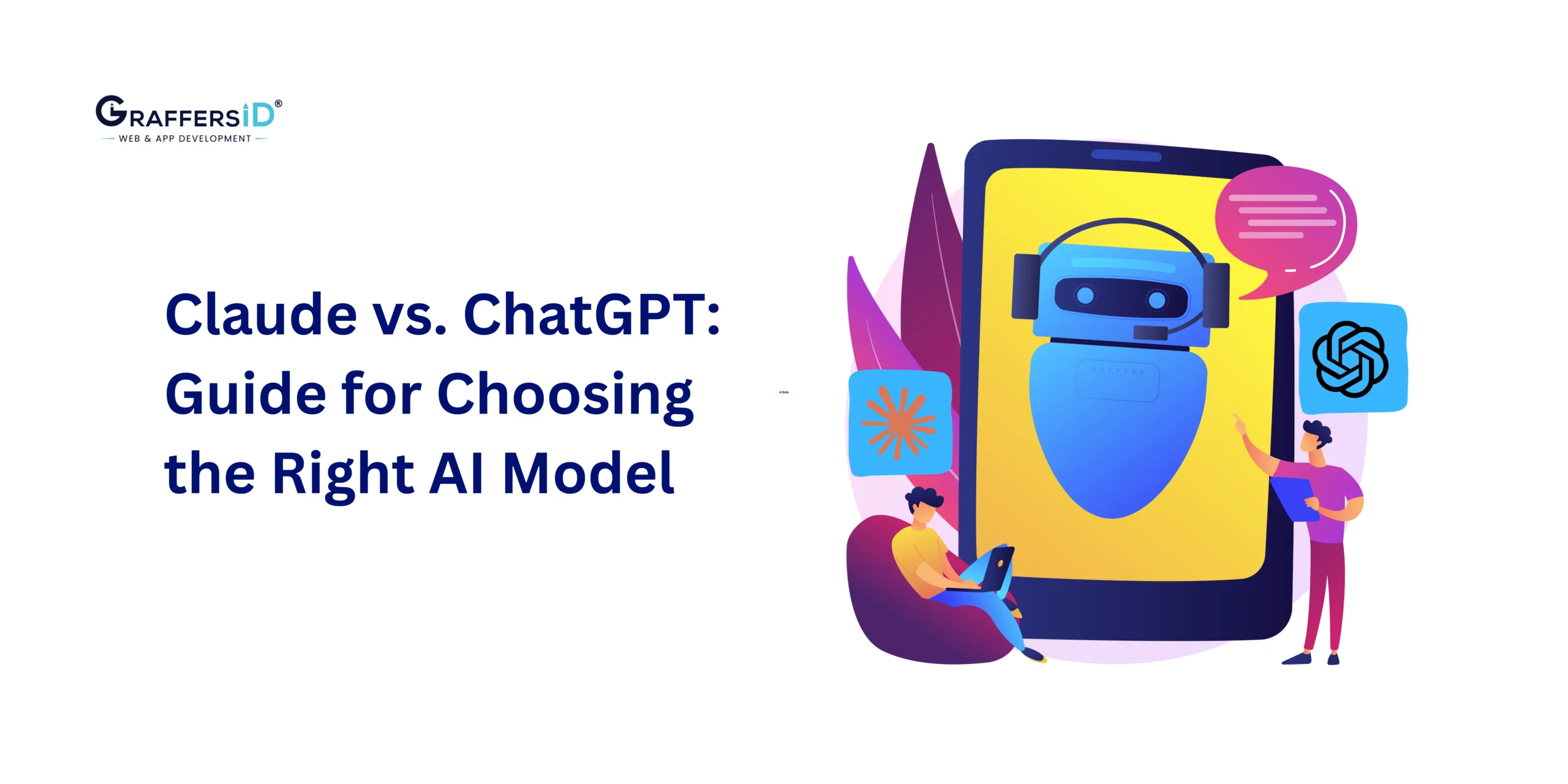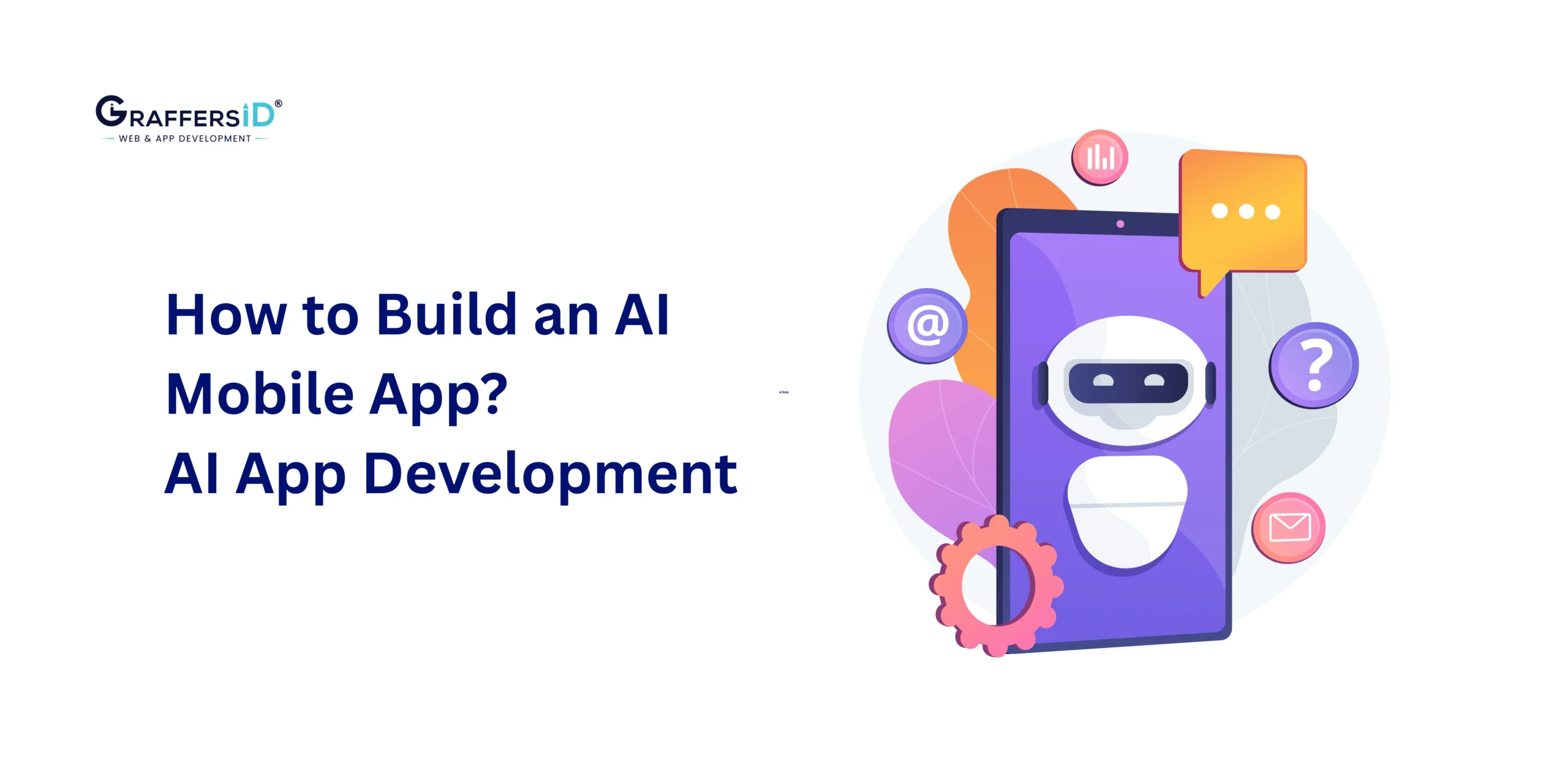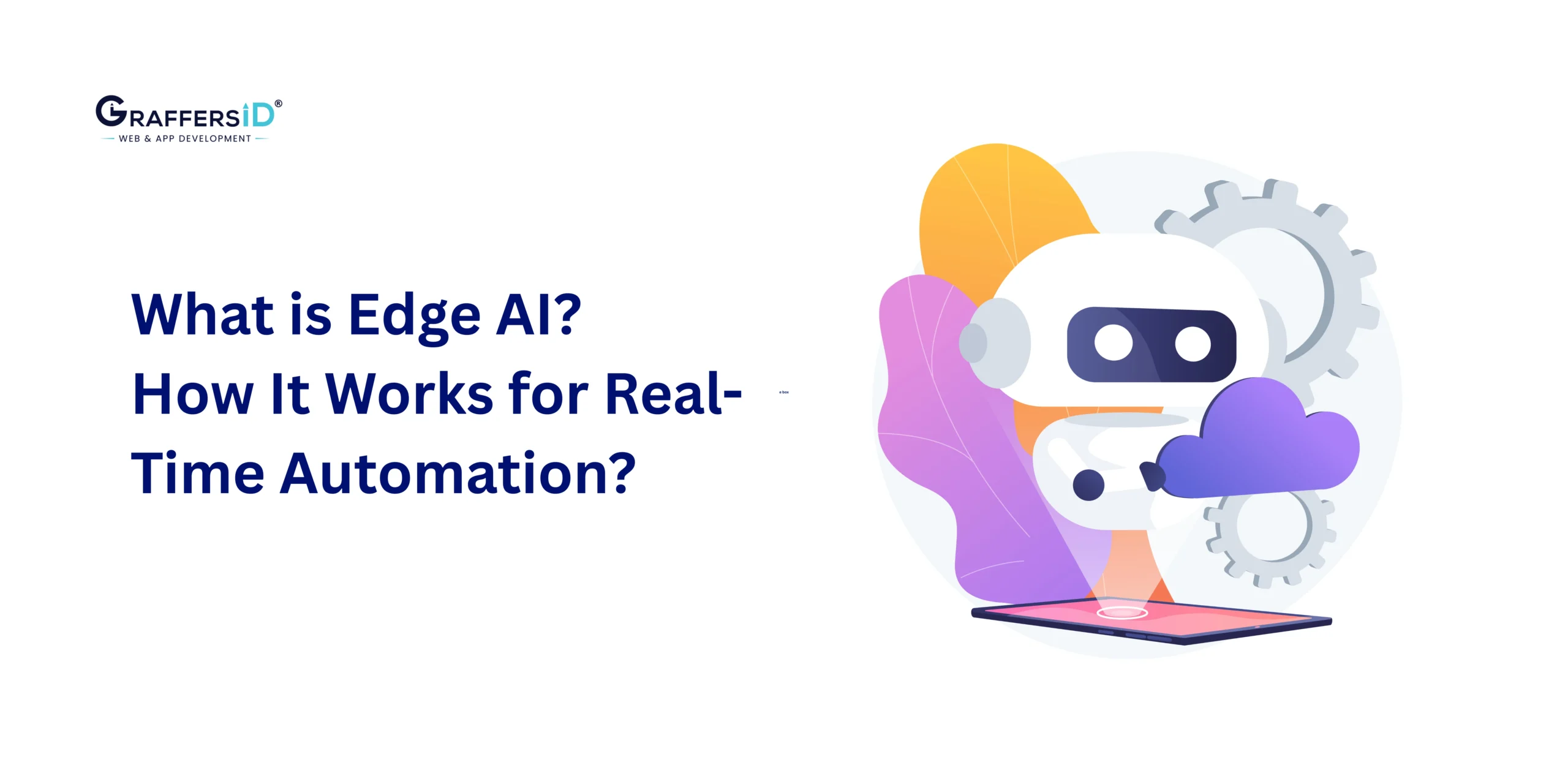Choosing the right ChatGPT version in 2026 isn’t as simple as it used to be. What began with a single model has now evolved into an entire ecosystem: GPT-3.5, GPT-4, GPT-4 Turbo, GPT-4o, GPT-4.5, GPT-5, and the latest GPT-5.1, each offering different levels of intelligence, speed, reasoning, and multimodal power.
And with so many variations, one question keeps coming up:
Which ChatGPT model is truly right for your use case?
Whether you’re optimizing customer experiences, building internal automation, scaling content operations, enhancing decision-making, or exploring AI-driven product innovation, the version you choose directly shapes performance, cost efficiency, and long-term ROI.
But here’s the challenge: Every model excels at something different. Some are better for complex reasoning. Others deliver the fastest responses. Some are built for multimodal workflows, while others offer unbeatable cost-to-performance value for startups and enterprises.
This 2026 guide breaks down each ChatGPT version, explains how they actually differ, and helps you pick the perfect model based on:
-
your business goals and tech maturity,
-
your workflow complexity,
-
and the level of automation or intelligence you want to achieve.
By the end, you’ll know exactly which ChatGPT version delivers the best outcomes for your team, without overspending, overengineering, or underutilizing the power of modern AI.
What is ChatGPT?

ChatGPT is OpenAI’s multimodal AI assistant built on the GPT (Generative Pre-trained Transformer) architecture. In 2026, ChatGPT supports:
- Text, image, audio, and video understanding
- Memory 2.0 for deep personalization
- Agentic AI with task planning + tool execution
- Tool integrations such as Browser+, Python (ADA), and DALL·E 4
- Enterprise-grade reasoning for automation and research
ChatGPT has evolved from a conversational chatbot to a full-scale AI operating system for developers, marketers, product teams, and enterprises.
Evolution of GPT Models (2018–2026)
The evolution of GPT shows how quickly AI has advanced from basic text prediction to today’s multimodal, reasoning-driven assistants. Each version was built on the last, improving scale, accuracy, context handling, and real-world usability. Here is a list of all the major versions by date:
Source: OpenAI
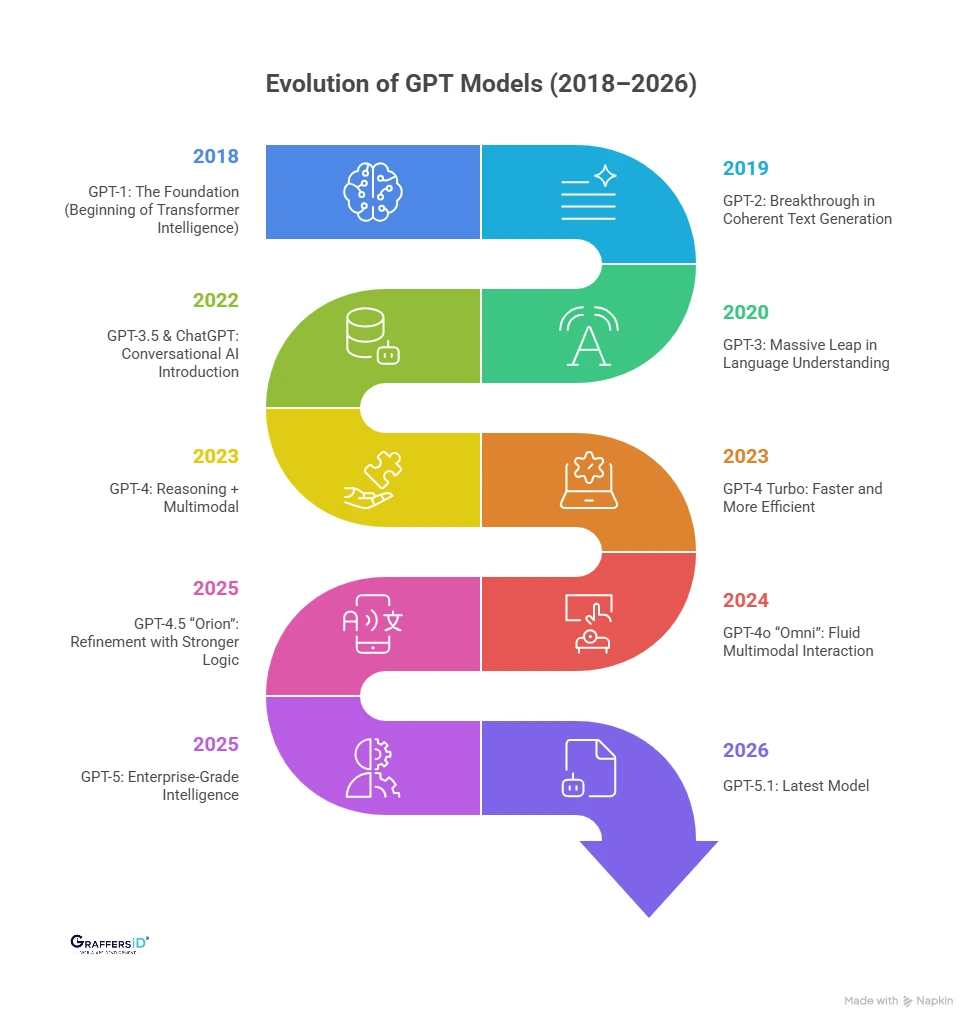
1. GPT-1 (2018): The Foundation (Beginning of Transformer Intelligence)
GPT-1 was OpenAI’s first attempt at developing a generative pre-trained transformer model. This initial model had 117M parameters and served as a proof of concept for large language models. It demonstrated that a transformer-based model trained on large datasets could understand and generate coherent language, laying the groundwork for future versions.
2. GPT-2 (2019): Breakthrough in Coherent Text Generation
GPT-2 was expanded to 1.5B parameters, highly improving coherence in long-form text generation. However, OpenAI first delayed the full release due to concerns about possible misuse. It was later released publicly, and its ability to generate coherent, multi-paragraph content amazed developers.
3. GPT-3 (2020): Massive Leap in Language Understanding
A massive leap with 175B parameters, GPT-3 represented a massive scale-up, with drastically improved performance in understanding context, answering questions, writing code, and more. It became the foundation for many AI applications worldwide and gained widespread adoption across writing, customer support, education, and more.
4. GPT-3.5 & ChatGPT (2022)
This marked the introduction of a conversational AI product based on GPT-3.5. With the launch of ChatGPT, OpenAI introduced a user-facing product focused on human-like interaction. This model could remember the flow of conversations, answer follow-up questions intelligently, and mimic a human conversational tone, making it user-friendly for both casual and professional uses.
5. GPT-4 (2023): Reasoning + Multimodal
GPT-4 introduced a major leap in reasoning accuracy, deeper contextual understanding, and more structured memory behavior. It significantly reduced hallucinations and became far more reliable for complex tasks such as debugging code, technical documentation, legal or financial analysis, and advanced decision-making. It also marked the beginning of multimodal capabilities and early experimental support for persistent memory.
Read More: ChatGPT vs. DeepSeek vs. Google Gemini: Which AI Model is Best for Developers?
6. GPT-4 Turbo (2023)
A faster, more cost-efficient, and optimized version of GPT-4, this model delivered significantly improved response speed, reduced operational expenses, and an expanded context window, enabling users to process, analyze, and integrate much larger datasets in a single session. It quickly became a go-to choice for enterprise workflows, ideal for managing large codebases, lengthy documents, and real-time, high-volume data processing across complex business environments.
7. GPT-4o “Omni” (2024)
GPT-4o, where the “o” stands for Omni, is built for fully fluid multimodal interaction. This model can natively process and respond to text, audio, and image inputs without needing separate pipelines or plugins. It supports real-time voice conversations, understands visual inputs like diagrams, charts, documents, and photos, and delivers responses with a natural, human-like tone and conversational flow.
It’s available free with usage limits and unlocked completely under the ChatGPT Plus plan, making it one of the most accessible high-performance models for everyday and professional use.
8. GPT-4.5 “Orion” (2025)
A refinement over GPT-4o with stronger logic, efficiency, multilingual accuracy, and improved memory. Combination of unsupervised pre-training, supervised fine-tuning, and RLHF (Reinforcement Learning from Human Feedback). Supports more than 15 languages. Its key use cases include complex data analysis in developer tools and as AI copilots for software teams. This model reduced hallucinations and better factual consistency across long sessions.
9. GPT-5 (2025)
GPT-5 represents OpenAI’s major leap toward enterprise-grade intelligence, combining a massive 272K context window, advanced agentic AI behavior, and deep file-level understanding for real-world workflows. With the ability to process entire books, large codebases, research documents, and multi-format datasets in one session, GPT-5 drastically reduces fragmentation in long tasks.
10. GPT-5.1 (2026): Latest Model
GPT-5.1 builds on the strengths of GPT-5 with sharper reasoning, faster and smoother multimodal processing, and significantly improved autonomous task handling. It delivers more consistent real-world execution, reduced latency, and better adherence to instructions, making it ideal for complex enterprise workflows and agent-driven automation. This version is optimized for reliability at scale, offering the most polished and production-ready ChatGPT experience yet.
Each version of GPT has built on the strengths of its predecessor, enhancing reasoning, speed, cost efficiency, memory, and overall usability.
ChatGPT Models Comparison (2026)
| Version | Year | Context
Window |
Multimodal | Best For |
| GPT-3.5 | 2022 | 8K–32K | No | Free users, basic queries |
| GPT-4 | 2023 | 8K–128K | Yes | Content, research, writing |
| GPT-4 Turbo | 2023 | 128K | Yes | Cost-effective professional workflows |
| GPT-4.5 Orion | 2025 | 200K+ | Yes | Developer tools, multilingual tasks |
| GPT-5 | 2025 | 272K | Yes | Enterprise automation & reasoning |
| GPT-5.1 | 2026 | 272K optimized | Advanced multimodal (text-image-audio-video) | Best overall: enterprise AI, agentic systems, coding copilots |
Which is the Latest ChatGPT Model in 2026?
The latest ChatGPT version is GPT-5.1, released on November 12, 2025. Some prominent features of GPT-5.1 are:
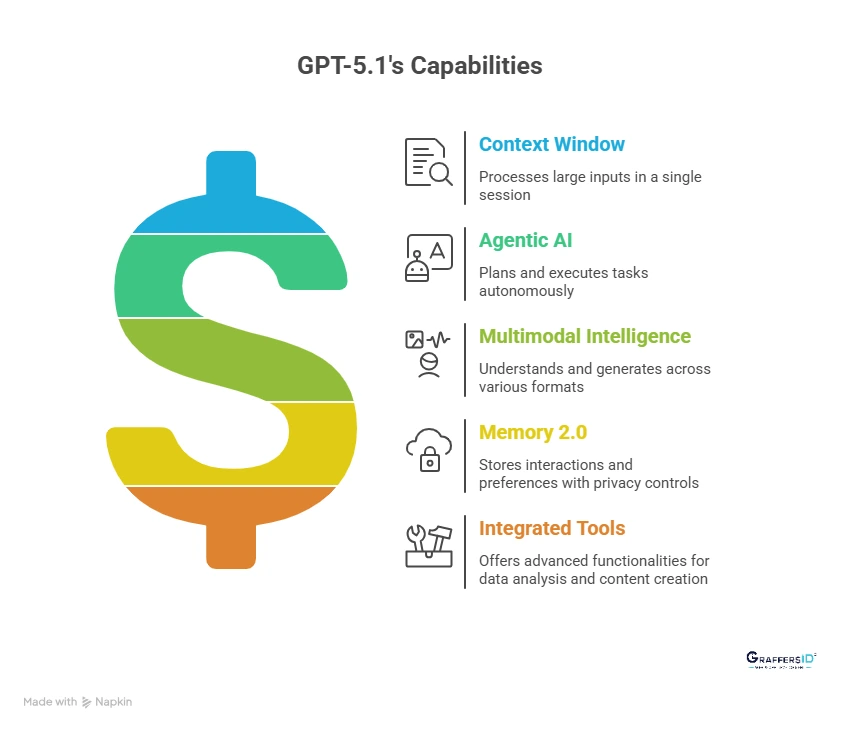
1. 272K Optimized Context Window
Processes massive inputs, including entire codebases, research repositories, product documentation, or long-form datasets, in a single session. Businesses can feed large files without breaking them into parts, saving time and reducing errors.
2. Advanced Agentic AI
GPT-5.1 can plan and prioritize tasks autonomously, execute workflows across integrated tools, maintain task memory across sessions, and complete multi-step objectives without constant supervision. This makes it ideal for automation, research, and enterprise operations requiring high-level reasoning.
3. Multimodal Intelligence
Capable of understanding and generating across text, images, audio, video, diagrams and charts, and UI/UX layouts. Enabling next-level creativity, content generation, and analysis in a single AI assistant.
4. Memory 2.0 for Enterprises
Stores past interactions, user preferences, and workflow context consistently across sessions, while offering enhanced privacy and compliance controls suitable for large organizations.
5. Integrated Tools
- Python Tool (Advanced Data Analysis / Code Interpreter): Perform data analysis, predictive modeling, and complex calculations.
- DALL·E 4: Generate images, edit visuals, and create UI prototypes from text prompts.
- Browser+: Access real-time data, verify facts, and enhance market research and trend analysis.
- File Intelligence: Handle PDFs, spreadsheets, slide decks, and datasets, delivering structured insights and summaries instantly.
Best ChatGPT Versions to Use in 2026
Choosing the right ChatGPT version in 2026 depends on your needs, budget, and workflow complexity. Here’s a clear guide to help you select the most suitable model for your team or organization:
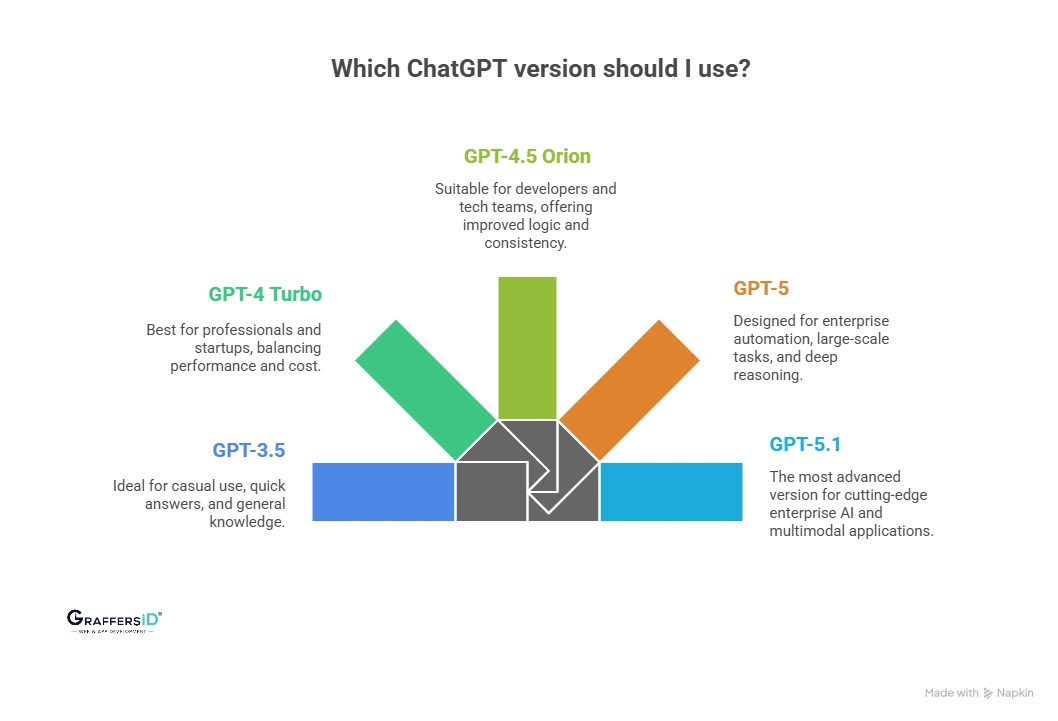
1. For Casual Use: GPT-3.5 (Free)
-
Best for: Quick answers, general knowledge, learning, brainstorming, and everyday queries.
-
Why choose it: GPT-3.5 is accessible, lightweight, and free to use, making it ideal for students, hobbyists, or individuals who don’t require enterprise-level capabilities.
2. For Professionals & Startups: GPT-4 Turbo
-
Best for: Content creation, research, coding assistance, and day-to-day professional workflows.
-
Why choose it: GPT-4 Turbo balances performance, cost, and speed. It offers enhanced reasoning and supports multimodal inputs, making it suitable for small teams and startups aiming to maximize productivity.
3. For Developers & Tech Teams: GPT-4.5 Orion
-
Best for: Developer tooling, multilingual tasks, complex reasoning, and software projects.
-
Why choose it: GPT-4.5 Orion improves logic and consistency over previous versions, making it ideal for technical teams who need reliable AI copilots for coding, testing, or multilingual content generation.
4. For Enterprise Automation: GPT-5
-
Best for: Large-scale enterprise tasks, business automation, and research-heavy workflows.
-
Why choose it: GPT-5 brings a massive 272K context window, agentic AI abilities, and enterprise-grade stability. It is suitable for companies seeking strong automation, deep reasoning, and complex decision support.
5. For Best Overall Performance in 2026: GPT-5.1
-
Best for: Cutting-edge enterprise AI, agentic tasks, and multimodal applications.
-
Why choose it: GPT-5.1 builds on GPT-5 with faster multimodal processing, improved reasoning, and more stable real-world execution. It’s the most reliable version for companies aiming to implement advanced AI agents, automation systems, and large-scale AI-driven projects.
How to Integrate ChatGPT into Your Apps, Tools, or Workflows in 2026?
Today, businesses don’t just use ChatGPT for conversations; they embed it directly into apps, platforms, and workflows to boost productivity, automate processes, and enhance decision-making. Here’s a step-by-step guide for integrating GPT into your operations.
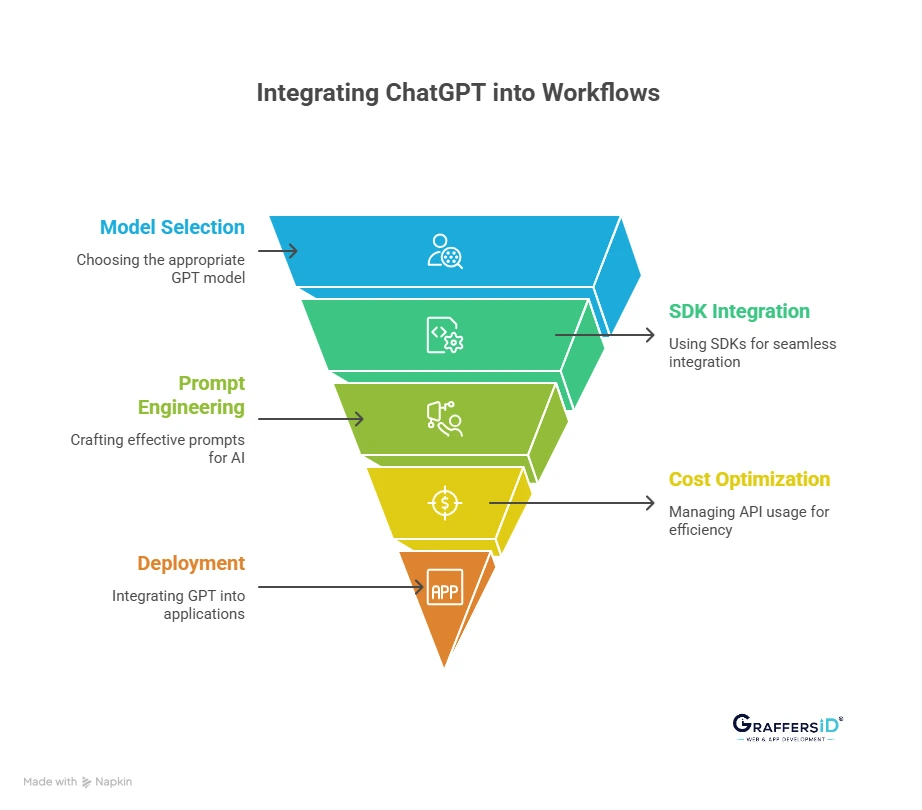
Step 1: Get API Access
The first step is to register on the OpenAI Platform and obtain your API key. This key allows your applications to securely access ChatGPT models.
Step 2: Select the Right GPT Model
Choosing the right model is critical for performance and cost-efficiency.
- GPT-4 Turbo is ideal for lightweight content, summaries, and routine automation.
- GPT-5 excels at research, analysis, and multi-step business automation.
- GPT-5.1 is optimized for agentic workflows, coding copilots, and multimodal applications combining text, audio, images, and video.
Read More: OpenAI’s GPT vs. Google Gemini: Which AI Model is Better for Workflow Automation in 2026?
Step 3: Use the Official SDK
OpenAI provides SDKs for Python, Node.js, and REST APIs, making integration straightforward. Modern frameworks like Next.js, React, Laravel, and Django now support GPT plugins natively, allowing seamless embedding of AI into your applications or backend systems.
Step 4: Build Smart, Context-Aware Prompts
The quality of your AI integration depends on your prompts. Create context-specific instructions to get actionable outputs. For example, “Act as a senior React engineer. Explain this bug and provide an optimized fix,” or “Draft a PRD for this feature request.” Well-structured prompts save time, reduce errors, and improve AI relevance.
Step 5: Optimize Costs and Accuracy
Managing API usage is essential for scaling AI effectively. Set rate limits to control expenses, use embeddings with vector databases for faster recall, cache frequently requested data, and split large files into chunks for smooth processing. These strategies ensure reliable and cost-efficient AI performance at scale.
Step 6: Deploy GPT Across Apps and Workflows
Finally, integrate GPT into your user interfaces and business processes. Examples include chat widgets for customer support, automated documentation generators, AI copilots for teams, dashboards powered by real-time AI insights, and workflow automation through tools like Zapier, Make, Vercel AI SDK, or custom agents built with AnythingLLM.
Conclusion: Choosing the Best ChatGPT Version for 2026
From GPT-1’s simple text generation to GPT-5.1’s autonomous, multimodal intelligence, ChatGPT has evolved into a powerful business-grade AI assistant. Choosing the right version depends on your goals, workflows, and level of AI adoption.
- GPT-4 Turbo: Ideal for productivity-focused tasks, content workflows, and cost-efficient AI integration.
- GPT-4.5 Orion: Optimized for multilingual operations, developer workflows, and complex data analysis, perfect for teams needing precision and efficiency.
- GPT-5.1: The most advanced model in 2026, offering stable real-world execution, agentic AI capabilities, and seamless multimodal performance for enterprise-scale automation and intelligent systems.
For businesses aiming to automate workflows, build intelligent AI agents, enhance customer experiences, or deploy production-ready AI systems, GPT-5.1 delivers the highest ROI, reliability, and scalability.
At GraffersID, we help businesses build custom AI agents, intelligent chatbots, AI-powered automation, and AI-driven web & app solutions. Hire AI developers to create enterprise-grade AI solutions tailored to your business.

